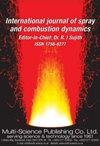在不同反应物混合的燃烧室中,稀薄爆前火焰行为和动力学研究,用于稀薄爆的早期检测
IF 2.1
4区 工程技术
Q3 ENGINEERING, MECHANICAL
International Journal of Spray and Combustion Dynamics
Pub Date : 2018-11-18
DOI:10.1177/1756827718812519
引用次数: 16
摘要
贫爆是燃气轮机燃烧室采用贫燃料-空气混合气运行以达到排放标准所面临的主要挑战之一。我们通过实验研究了过渡到稀薄井喷过程中的火焰行为和热释放率波动动力学。该研究包括火焰可视化和估计几种措施,以预测预混和部分预混火焰(使用燃料端口F1至F5)在涡流稳定的倾卸燃烧室中的稀薄井喷。为此,我们通过带窄带通滤波器的光电倍增管获得了CH*化学发光的非定常放热率。为了评估不同的统计测量,我们使用国家仪器Labview软件,同时获取热释放率振荡。对于预混和部分预混火焰,这些措施和火焰行为表现出不同的趋势,在某些情况下,甚至相反的趋势。然而,在预混和部分预混火焰中,放热率波动的平均值和均方根值都随着等效比的减小而减小。进一步,我们证明了利用希尔伯特变换计算的热释放率波动的平均频率值是一个很好的指标贫化井喷。除了对贫爆的早期预测外,不同的热释放率振荡统计,如峰度和偏度,只能识别预混料(F1和F2)和预混水平较低的火焰(F3)发生贫爆。对于像F4和F5这样高度不混合的火焰,它们是没有用的。另一方面,概率密度函数对预混和部分预混火焰都是有用的。简而言之,我们提出了之前所述的不同措施对预混和部分预混火焰的稀薄井喷的识别和早期预测的相对重要性。本文章由计算机程序翻译,如有差异,请以英文原文为准。
Investigation of flame behavior and dynamics prior to lean blowout in a combustor with varying mixedness of reactants for the early detection of lean blowout
Lean blowout is one of the major challenges faced when the gas turbine combustors are operated with lean fuel–air mixture to meet the emission norm. We experimentally study the flame behavior and the dynamics of heat release rate fluctuations during a transition to lean blowout. The study comprising flame visualization and estimating several measures to predict lean blowout for both premixed and partially premixed flames (using fuel ports F1 to F5) in a swirl stabilized dump combustor. To that end, we acquire unsteady heat release rate in terms of CH* chemiluminescence obtained through a photomultiplier tube with a narrow band-pass filter. For evaluating different statistical measures, we use National Instrument Labview software while acquiring the heat release rate oscillations. For premixed and partially premixed flames, such measures and the flame behavior show a different and, in some cases, even opposite trends as lean blowout is approached. However, in both premixed and partially premixed flames, the mean and root mean square values of the heat release rate fluctuation decrease as we decrease the equivalence ratio. Further, we show that the value of mean frequency calculated using Hilbert transform of the heat release rate fluctuations is a good indicator of lean blowout. Apart from the early prediction of lean blowout, different statistics of heat release rate oscillations, such as kurtosis and skewness, are shown to identify only the occurrence of lean blowout for premixed (F1 and F2) and flames with lower level of premixing (F3). They are not useful for the flames with high levels of unmixedness like F4 and F5. On the other side, probability density function is seen useful for both premixed and partially premixed flames. In short, we present the relative importance of different measures stated earlier for the identification and early prediction of lean blowout for both premixed and partially premixed flames.
求助全文
通过发布文献求助,成功后即可免费获取论文全文。
去求助
来源期刊

International Journal of Spray and Combustion Dynamics
THERMODYNAMICS-ENGINEERING, MECHANICAL
CiteScore
2.20
自引率
12.50%
发文量
21
审稿时长
>12 weeks
期刊介绍:
International Journal of Spray and Combustion Dynamics is a peer-reviewed open access journal on fundamental and applied research in combustion and spray dynamics. Fundamental topics include advances in understanding unsteady combustion, combustion instability and noise, flame-acoustic interaction and its active and passive control, duct acoustics...
 求助内容:
求助内容: 应助结果提醒方式:
应助结果提醒方式:


